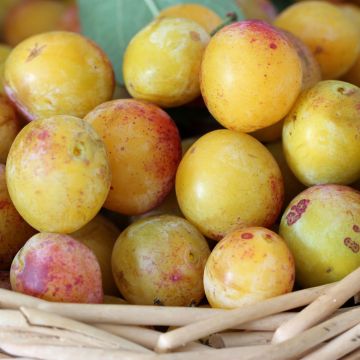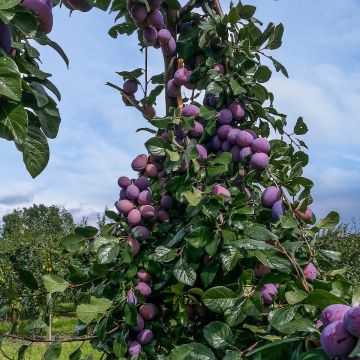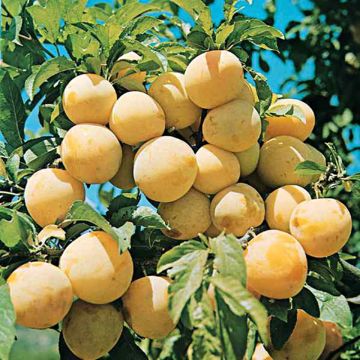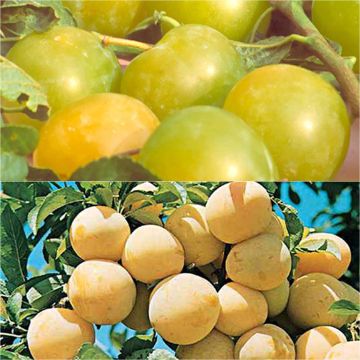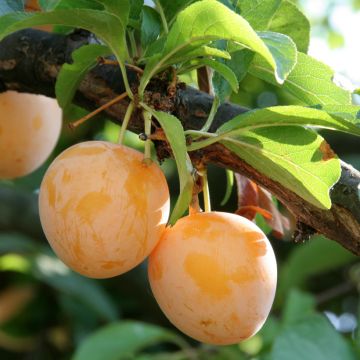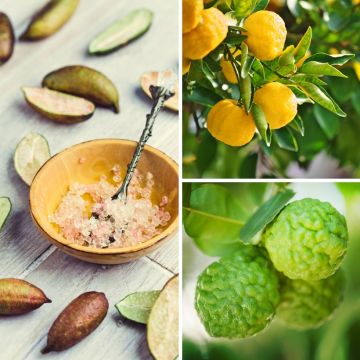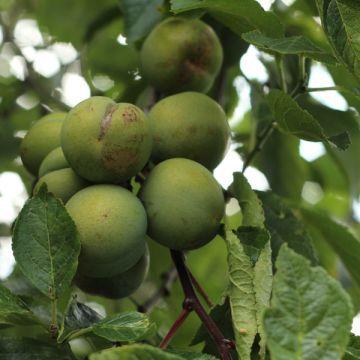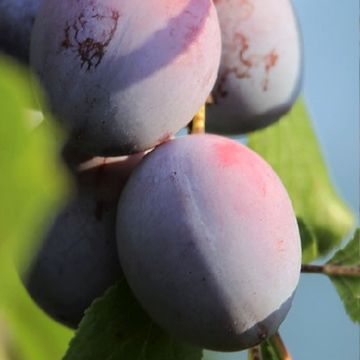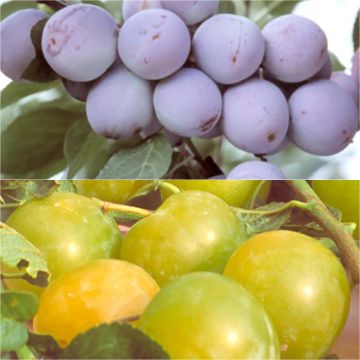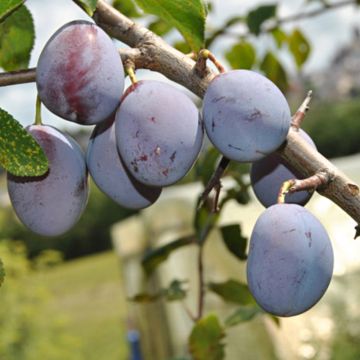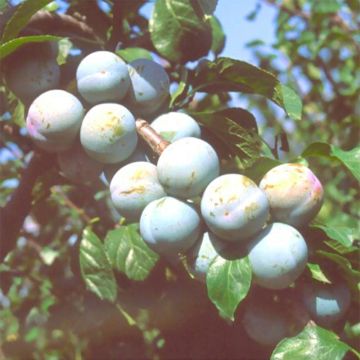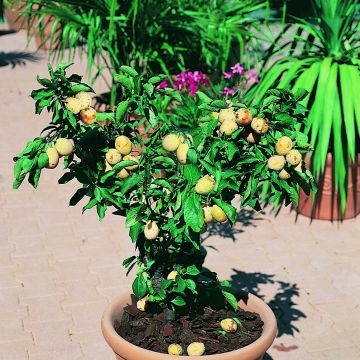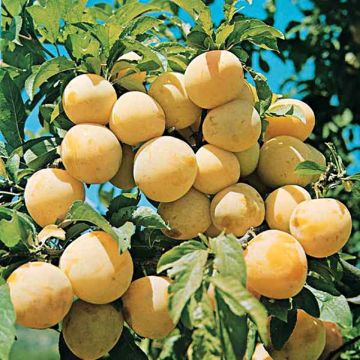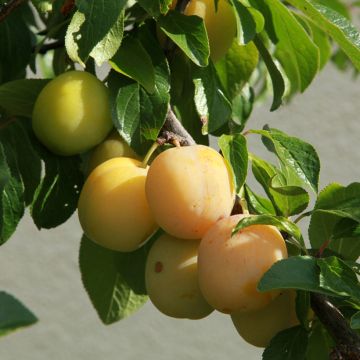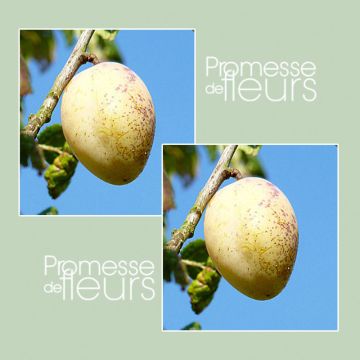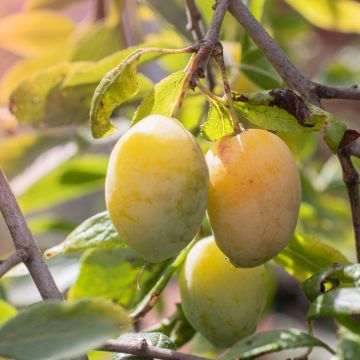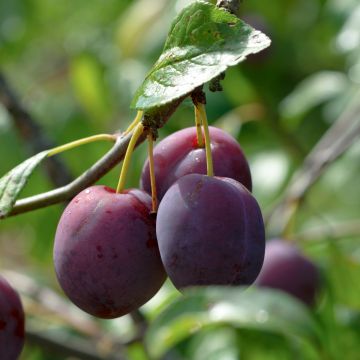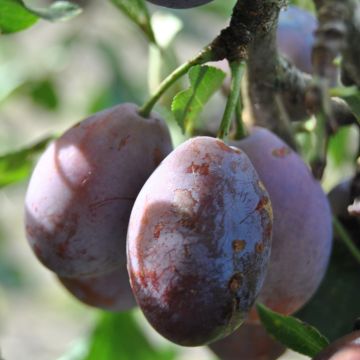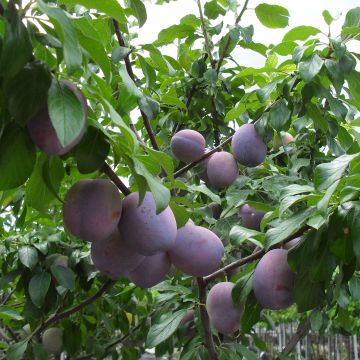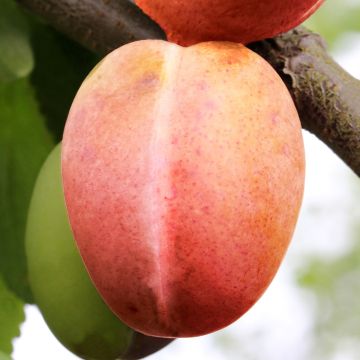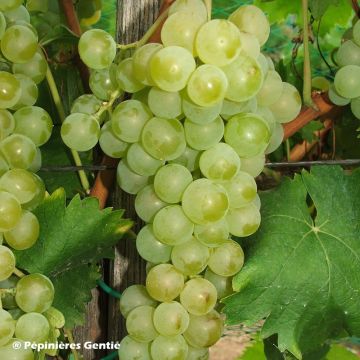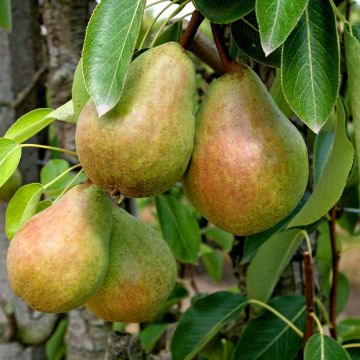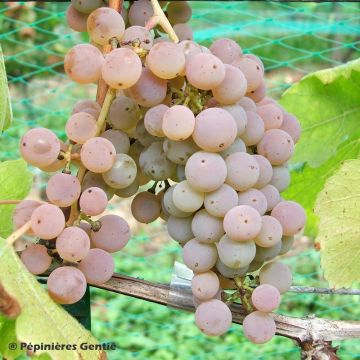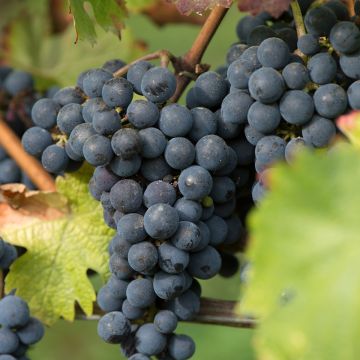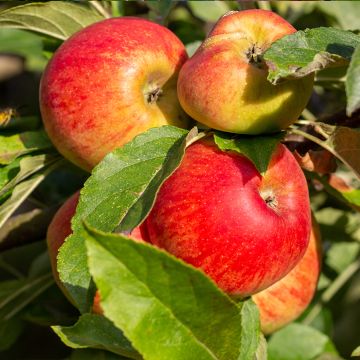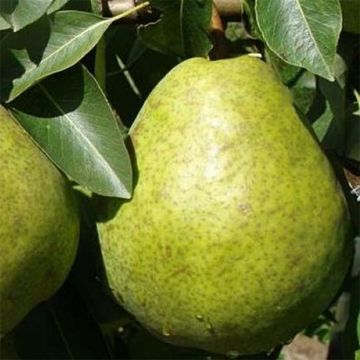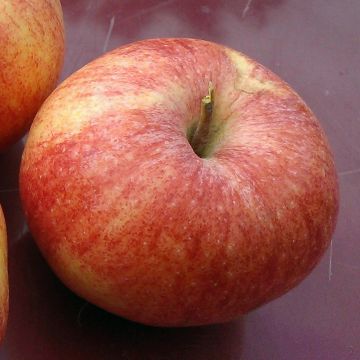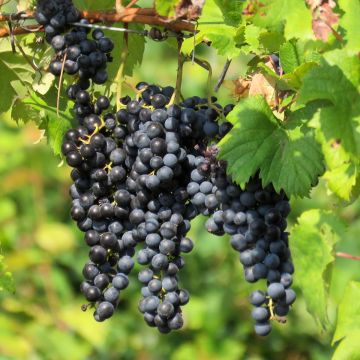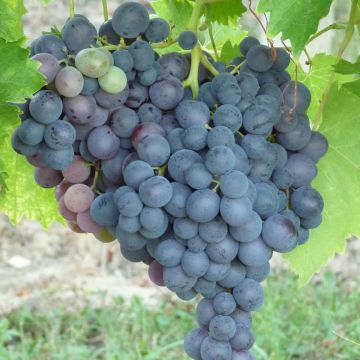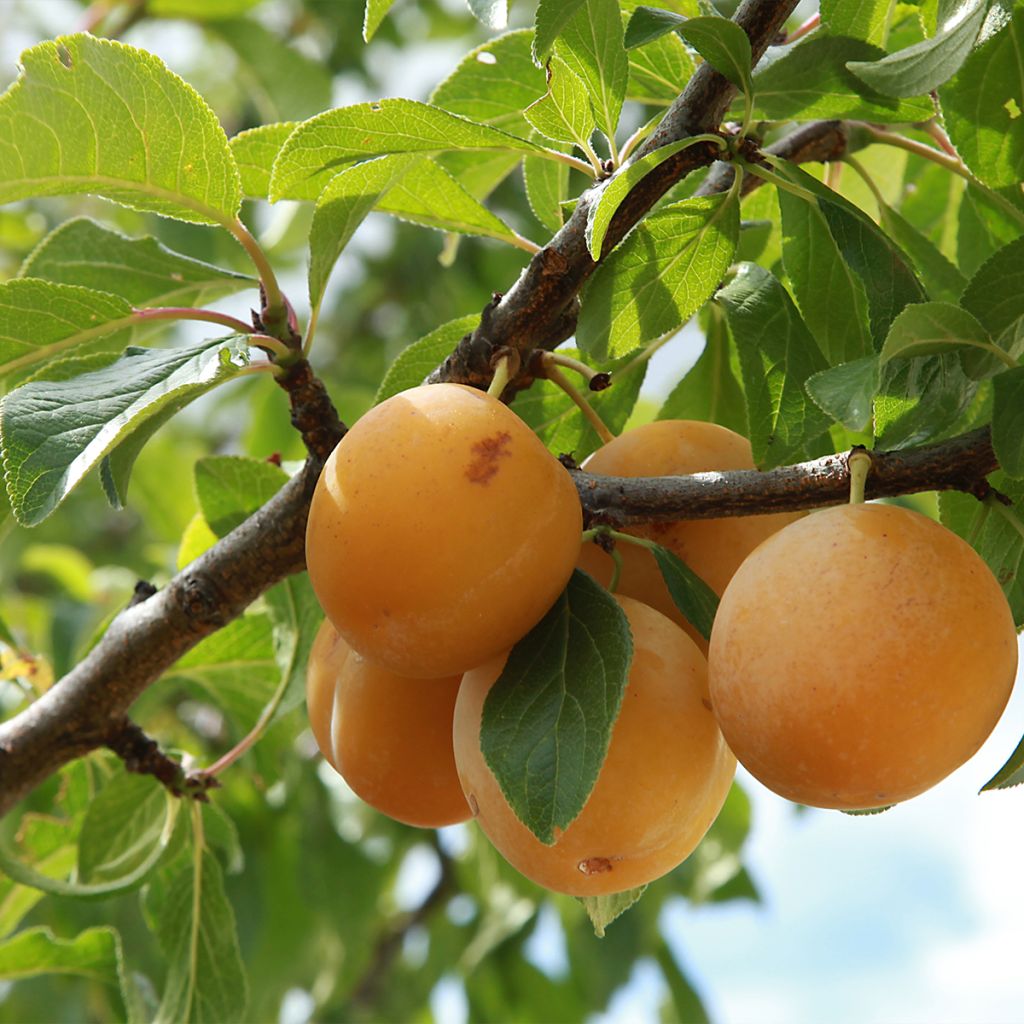

Saint Catherine Plum Tree
Saint Catherine Plum Tree
Prunus x domestica Sainte Catherine
Plum 'Saint Catherine'
Why not try an alternative variety in stock?
View all →Order in the next for dispatch today!
Dispatch by letter from €3.90.
Delivery charge from €5.90 Oversize package delivery charge from €6.90.
More information
This item is not available in your country.
Schedule delivery date,
and select date in basket
This plant carries a 6 months recovery warranty
More information
We guarantee the quality of our plants for a full growing cycle, and will replace at our expense any plant that fails to recover under normal climatic and planting conditions.
Oversize package: home delivery by special carrier from €6.90 per order..
Express home delivery from €8.90.
Oversize package: home delivery by special carrier from €6.90 per order..
Express home delivery from €8.90.
Description
Prunus domestica 'Saint Catherine' is a variety of plum with medium vigour. It is self-fertile and highly productive. It produces an abundance of white flowers in April, which are attractive to bees. During summer, these flowers develop into medium to large-sized plums with a slightly elongated shape, and a beautiful yellow-gold colour with red spots on the side exposed to the sun. They are ready to be harvested from late August. Their juicy flesh is sweet, highly aromatic, and has a pleasant honey-like taste. These plums can be consumed fresh, used in tarts or jams, or dried to make prunes. It should be grown in full sun in well-drained soil.
Plum trees are part of the extensive Rosaceae family, which includes most temperate climate fruit trees (apples, pears, apricots, peach, cherries, and quince), as well as small fruits (blackberries, raspberries, strawberries). The Prunus genus itself is extremely large, with over 300 species, both fruit-bearing (almond, peach) and ornamental, including numerous ornamental trees and shrubs. Prunus domestica is probably native to Asia Minor (Syria) and would have been introduced to Rome, along with many other species, following the Roman conquests. According to some authors, its introduction to Europe may be more closely linked to the Crusades.
'Saint Catherine' is an old variety that may originate from the village of Sainte-Catherine-de-Fierbois, located south of Tours. It was cultivated in Louis XIV's vegetable garden and is the ancestor of the famous Prune de Tours, renowned throughout France in the 19th century. It has a moderate growth habit, forming a small tree that reaches a height of 5 to 6m (16 to 20ft), and a width of 3 to 5m (10 to 16ft), with a relatively upright form. In April, it produces clusters of single, white, 5-petalled flowers that are rich in nectar, ensuring that a certain number survive the potential late frosts. This variety is self-fertile, but cross-pollination with another tree will result in a more abundant harvest. Once pollinated, the flowers develop into drupes, the fleshy fruit with a stone that we know as plums. The plums ripen in late August and can then be harvested. Their juicy flesh is sweet, highly aromatic, and has a pleasant flavour that earns them the evocative name of honey plums. These fruits can be consumed fresh right after harvesting and can also be used in tarts or jams. They can also be dried to make prunes. Plums are refreshing fruits that are relatively low in calories, but rich in vitamin E.
Hardy down to -17°C (1.4°F), or even lower, this plum tree is easy to grow and relatively low-maintenance once well-established.
This moderately-sized plum tree will fit well in most gardens and can be combined with other plants to create a rustic look. The Smoky Amelanchier would be a great choice with its beautiful spring white flowers and autumn colours. You can enjoy its fruit, which resembles blueberries, two months before these plums are ready. In the same vein, the European Cornel would also be a good candidate. This shrub bears yellow flowers before the leaves appear, which then turn reddish-purple in autumn. Its fruits are also edible.
Report an error about the product description
Saint Catherine Plum Tree in pictures
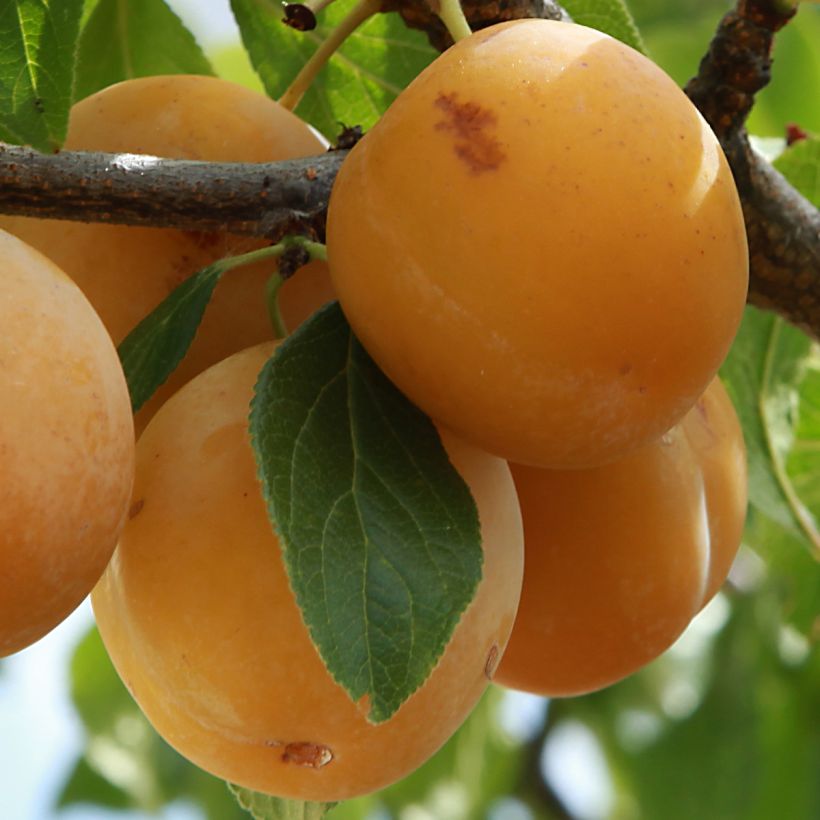

Plant habit
Fruit
Flowering
Foliage
Botanical data
Prunus
x domestica
Sainte Catherine
Rosaceae
Plum 'Saint Catherine'
Cultivar or hybrid
Other Plum Trees
Planting and care
It prefers deep clay-limestone soil that is not too dry. It can adapt to other types of soil. It is quite demanding in terms of sunlight.
This tree likes deep soil. Dig a planting hole at least 50cm (20in) on all sides. It also appreciates some humidity, so water it regularly in summer and autumn in the first years. Once well rooted, it is a hardy and undemanding tree.
Planting period
Intended location
Care
This item has not been reviewed yet - be the first to leave a review about it.
Ancient and local varieties
Haven't found what you were looking for?
Hardiness is the lowest winter temperature a plant can endure without suffering serious damage or even dying. However, hardiness is affected by location (a sheltered area, such as a patio), protection (winter cover) and soil type (hardiness is improved by well-drained soil).

Photo Sharing Terms & Conditions
In order to encourage gardeners to interact and share their experiences, Promesse de fleurs offers various media enabling content to be uploaded onto its Site - in particular via the ‘Photo sharing’ module.
The User agrees to refrain from:
- Posting any content that is illegal, prejudicial, insulting, racist, inciteful to hatred, revisionist, contrary to public decency, that infringes on privacy or on the privacy rights of third parties, in particular the publicity rights of persons and goods, intellectual property rights, or the right to privacy.
- Submitting content on behalf of a third party;
- Impersonate the identity of a third party and/or publish any personal information about a third party;
In general, the User undertakes to refrain from any unethical behaviour.
All Content (in particular text, comments, files, images, photos, videos, creative works, etc.), which may be subject to property or intellectual property rights, image or other private rights, shall remain the property of the User, subject to the limited rights granted by the terms of the licence granted by Promesse de fleurs as stated below. Users are at liberty to publish or not to publish such Content on the Site, notably via the ‘Photo Sharing’ facility, and accept that this Content shall be made public and freely accessible, notably on the Internet.
Users further acknowledge, undertake to have ,and guarantee that they hold all necessary rights and permissions to publish such material on the Site, in particular with regard to the legislation in force pertaining to any privacy, property, intellectual property, image, or contractual rights, or rights of any other nature. By publishing such Content on the Site, Users acknowledge accepting full liability as publishers of the Content within the meaning of the law, and grant Promesse de fleurs, free of charge, an inclusive, worldwide licence for the said Content for the entire duration of its publication, including all reproduction, representation, up/downloading, displaying, performing, transmission, and storage rights.
Users also grant permission for their name to be linked to the Content and accept that this link may not always be made available.
By engaging in posting material, Users consent to their Content becoming automatically accessible on the Internet, in particular on other sites and/or blogs and/or web pages of the Promesse de fleurs site, including in particular social pages and the Promesse de fleurs catalogue.
Users may secure the removal of entrusted content free of charge by issuing a simple request via our contact form.
The flowering period indicated on our website applies to countries and regions located in USDA zone 8 (France, the United Kingdom, Ireland, the Netherlands, etc.)
It will vary according to where you live:
- In zones 9 to 10 (Italy, Spain, Greece, etc.), flowering will occur about 2 to 4 weeks earlier.
- In zones 6 to 7 (Germany, Poland, Slovenia, and lower mountainous regions), flowering will be delayed by 2 to 3 weeks.
- In zone 5 (Central Europe, Scandinavia), blooming will be delayed by 3 to 5 weeks.
In temperate climates, pruning of spring-flowering shrubs (forsythia, spireas, etc.) should be done just after flowering.
Pruning of summer-flowering shrubs (Indian Lilac, Perovskia, etc.) can be done in winter or spring.
In cold regions as well as with frost-sensitive plants, avoid pruning too early when severe frosts may still occur.
The planting period indicated on our website applies to countries and regions located in USDA zone 8 (France, United Kingdom, Ireland, Netherlands).
It will vary according to where you live:
- In Mediterranean zones (Marseille, Madrid, Milan, etc.), autumn and winter are the best planting periods.
- In continental zones (Strasbourg, Munich, Vienna, etc.), delay planting by 2 to 3 weeks in spring and bring it forward by 2 to 4 weeks in autumn.
- In mountainous regions (the Alps, Pyrenees, Carpathians, etc.), it is best to plant in late spring (May-June) or late summer (August-September).
The harvesting period indicated on our website applies to countries and regions in USDA zone 8 (France, England, Ireland, the Netherlands).
In colder areas (Scandinavia, Poland, Austria...) fruit and vegetable harvests are likely to be delayed by 3-4 weeks.
In warmer areas (Italy, Spain, Greece, etc.), harvesting will probably take place earlier, depending on weather conditions.
The sowing periods indicated on our website apply to countries and regions within USDA Zone 8 (France, UK, Ireland, Netherlands).
In colder areas (Scandinavia, Poland, Austria...), delay any outdoor sowing by 3-4 weeks, or sow under glass.
In warmer climes (Italy, Spain, Greece, etc.), bring outdoor sowing forward by a few weeks.


































